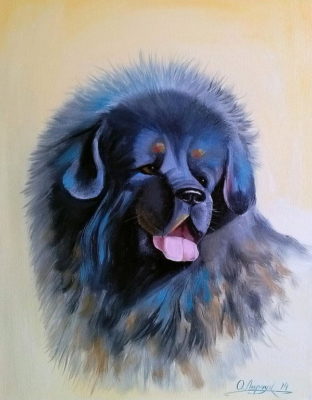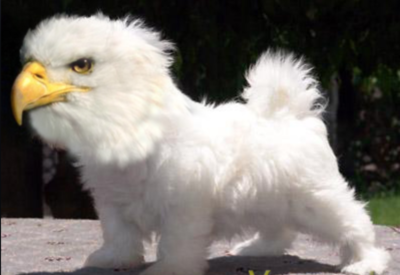

Roughly one per cent of vultures in Tibet are Tibetan bearded vultures which lay three eggs. The first egg produces a snake, the second produces a dog, and the third, a bird. It’s said that if one hears a dog barking high up in the mountains near a bearded vulture’s nest, a very small dog will be found there, and this dog is called, “Go Khyi,” the most respected dog in Tibet. For obvious reasons, this dog (seen at the right) is not recognized by any kennel club on earth, but it does give new meaning to the term, “bird dog,” doesn’t it?
Two much larger breeds of Tibet are the “Do Khyi” which means, “chained dog” or “dogs which may be tied,” and the Tsang Khyi (meaning “dog from Tsang, a place south of Lhasa). Both the Do Khyi and Tsang Khyi are Tibetan Mastiffs with the same ancestors, but each has a slightly different role.
The Do-Khyi accompanies Tibetan nomads and villagers; his job is to guard the flock of his village or master, and as such, these are very protective dogs. It’s a really bad idea to enter this dog’s property or territory without the permission of its owner.
The Tsang-Khyi is exclusively the companion of Buddhist monks and lamas, and is largely a monastery dog. The bones of this dog are typically heavier than that of a Do-Khyi, and it has more wrinkles than its kin. Because of its particular role, the Tsang-Khyi is far from being suitable for outdoor guardian dog work. Nomadic shepherds prefer a leaner dog, anyway, because it doesn’t eat as much as a Do-Khyi. That said, the Tsang-Khyi is still a guard dog who will fiercely defend its master, a monk or lama.
We circle back and conclude with another legend, this one about the Tsang-Khyi. According to Buddhist lore, these dogs are actually Rakshasas, or demons in disguise. It’s said that if a person threatens the well being of a monk or lama that the dog is guarding, the Rakshasa sheds its Tsang-Khyi disguise to protect its master.
Read this and this for more Tibetan Mastiff legends.
Image: Tibetan Mastiff in oil by Olha Darchuk is available as fine art, or in home decor and lifestyle items here.
